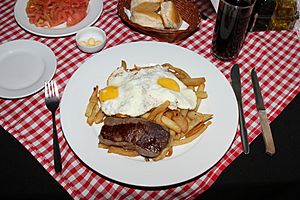Lomo a lo pobre facts for kids

|
|
| Course | Main (lunch) |
|---|---|
| Place of origin | Chile Peru |
| Serving temperature | Hot |
| Main ingredients | Beef, eggs, french fries |
| Ingredients generally used | Fried onions, rice, fried plantains |
| Variations | Bistec a lo pobre, bife a lo pobre |
Lomo a lo pobre is a popular and tasty meal from Peru and Chile. Its name can also be bistec a lo pobre or bife a lo pobre. This dish usually has a juicy piece of beef tenderloin (which is called lomo in Spanish). It comes with one or more sunny-side-up fried eggs on top. And, of course, a generous serving of crispy French fries. People often enjoy lomo a lo pobre for lunch or dinner.
Contents
What Does "A Lo Pobre" Mean?
The phrase "a lo pobre" means "in the style of the poor." There are a few ideas about how this name came to be.
Why the Name "A Lo Pobre"?
One idea is that in the 1800s, regular people in Peru ate big, hearty meals like this. These meals had lots of food and could be quite expensive. So, the name might have been a bit of a joke about how "poor" people were eating so well.
Another thought is that people in Lima, Peru, who didn't have much money, would often eat meat with lots of other foods like eggs, rice, and carbohydrates. Richer people might have eaten just meat with a simple vegetable. So, "a lo pobre" could have described a meal that was more filling and had many parts.
Today, this dish is eaten by everyone, no matter how much money they have. You can find it in fancy restaurants and simple ones. The name "a lo pobre" doesn't have any negative meaning anymore.
"A Lo Pobre" in Other Dishes
In Lima, Peru, the term "a lo pobre" can simply mean that a fried egg has been added to a dish. So, you might see other meals with this name, like grilled chicken breast (pechuga a lo pobre). It can also be added to dishes like arroz chaufa (fried rice), lomo saltado (stir-fried beef), salchipapas (sausage and fries), or even hamburgers.
See also
 In Spanish: Bistec a lo pobre para niños
In Spanish: Bistec a lo pobre para niños

